
VOL. 35, No. 1, 2020
Abstract : Metacognition is a required cognitive ability to achieve deep and meaningful learning that should be viewed from both an individual and social perspective. Recently, the transition from the earliest individualistic models to an acknowledgement of metacognition as socially situated and socially constructed has precipitated the study of metacognition in collaborative learning environments. This metacognitive construct was developed using the Community of Inquiry framework as a theoretical guide and tested applying qualitative research techniques by way of developing a metacognition questionnaire. The results indicate that in order to better understand the structure and dynamics of metacognition in teacher education programs; we must go beyond individual approaches to learning and consider metacognition in terms of complementary self- and co-regulation that integrates individual and shared regulation. This research study examines this shared metacognition framework and the use of digital technologies in the 3rd year of a Canadian Bachelor of Education program. Teacher candidates completed both the Shared Metacognition and Community of Inquiry surveys. The results indicate that a teacher must use digital technologies to intentionally design, facilitate, and direct a collaborative constructive learning environment in order for students to learn how to co-regulate their learning (shared metacognition).
Keywords: action research, student engagement, shared metacognition, Community of Inquiry (CoI), mixed method, teaching presence
Résumé: La métacognition est une capacité cognitive requise pour réaliser un apprentissage profond et significatif qui doit être considéré à la fois d'un point de vue individuel et social. Récemment, le passage des premiers modèles individualistes à une reconnaissance de la métacognition comme socialement située et socialement construite a amené à étudier la métacognition dans les environnements d'apprentissage collaboratif. Cette construction métacognitive a été développée en utilisant le cadre de la communauté d'enquête comme guide théorique et testée en appliquant des techniques de recherche qualitative en développant un questionnaire sur la métacognition. Les résultats indiquent que pour mieux comprendre la structure et la dynamique de la métacognition dans les programmes de formation des enseignants, nous devons aller au-delà des approches individuelles de l'apprentissage et considérer la métacognition en termes d'autorégulation complémentaire et de corégulation qui intègre la régulation individuelle et partagée. Cette étude de recherche examine ce cadre de métacognition partagé et l'utilisation des technologies numériques en 3e année d'un programme canadien de baccalauréat en éducation. Les enseignants candidats ont répondu aux sondages sur la métacognition et la communauté d'enquête. Les résultats indiquent qu'un enseignant doit utiliser les technologies numériques pour concevoir, faciliter et diriger intentionnellement un environnement d'apprentissage constructif collaboratif afin que les élèves apprennent à coréguler leur apprentissage (métacognition partagée).
Mots clés: engagement étudiant, métacognition partagée, Community of Inquiry (CoI), présence enseignante

This work is licensed under a Creative Commons Attribution 3.0 Unported License.
There has been an increased focus on the topic of student engagement in higher education in light of rising tuition costs and concerns about student success and retention rates (Regier, 2014). In order to address these issues, Littky and Grabelle (2004) advocate for a curriculum redesign that stresses relevance, relationships, and rigour (3R’s of engagement). It has been suggested that such a redesign would enable students to meaningfully engage in sustained learning experiences that may lead to a state of optimal flow. Csíkszentmihályi (1990) defines optimal flow as “the mental state of operation in which the person is fully immersed in what he or she is doing by a feeling of energized focus, full involvement, and success in the process of the activity” (p. 9).
At the core of meaningful student engagement is the concept of metacognition, which is simply “thinking about one’s thinking” (Chick, 2013, p. 1). Metacognition is key to learning how to learn. Metacognition means increasing awareness of the learning process and taking responsibility to control the learning process (Garrison, 2017). Metacognitive approaches to learning start with designing and planning the learning experience.
Recently, the focus in higher education has shifted from an individualistic to a more collaborative approach to learning (Kromydas, 2017). Consistent with this, Garrison and Akyol (2015a) have developed a shared metacognition construct, which is based on the Community of Inquiry framework (Garrison et al., 2000).
This research study explores how digital technologies in an educational technology course for pre-service teachers can be used to design, facilitate, and direct a course in order to help students develop their capacity for shared metacognition.
Garrison (2017) states that the Community of Inquiry (CoI) theoretical framework can provide the “context to conceptually and operationally define and operationalize metacognition in a socially shared environment” (p. 62). The three key elements or dimensions of the CoI framework are: social, cognitive, and teaching presence (Figure 1). It is at the convergence of these three mutually reinforcing elements that a collaborative constructivist educational experience is realized. Social presence creates the environment for trust, open communication, and group cohesion. Cognitive presence has been defined “as the extent to which learners are able to construct and confirm meaning through sustained reflection and discourse in a critical community of inquiry” (Garrison et al., 2001, p. 11). It has been operationalized through the developmental phases of inquiry: triggering events, exploration, integration, and resolution. The third and cohesive element, teaching presence, is associated with the design, facilitation, and direction of a community of inquiry. It is the unifying force that brings together the social and cognitive processes directed to personally meaningful and educationally worthwhile outcomes.
Figure 1
Community of Inquiry Framework (Garrison, 2017)
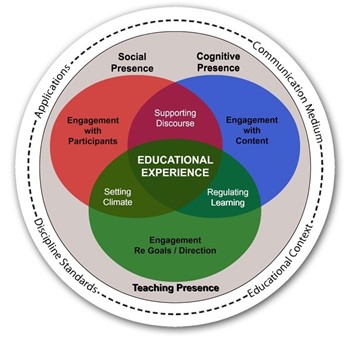
Shared metacognition (MC) exists at the intersection of the cognitive and teaching presence constructs and goes to the heart of a deep and meaningful educational learning experience (Figure 2). As such, we must understand shared MC and its role in a community of inquiry.
Figure 2
Community of Inquiry Elements, Categories, and Indicators
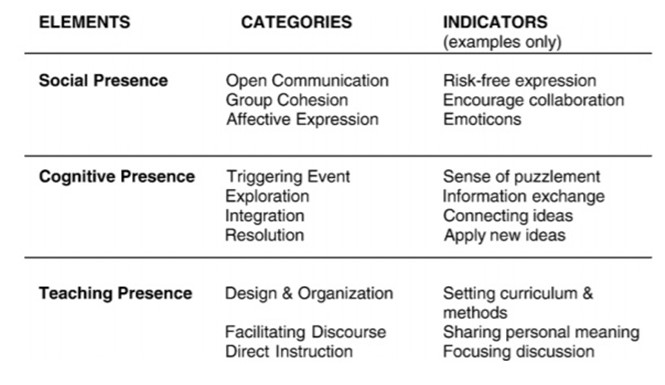
In terms of understanding shared MC and its role in a CoI, the premise is that developing metacognitive awareness and ability is core to becoming an effective inquirer. Metacognition has been generally accepted as consisting of two components: awareness of the inquiry process (monitor) and implementation strategies (regulation). Awareness allows the learner to monitor and actively manage and regulate the inquiry process. In short, metacognition awareness and implementation abilities provide the knowledge and strategies to monitor and manage effective inquiry. Most importantly, in a collaborative learning environment, awareness and implementation strategies are developed through critical discourse and the requirement of participants to explain and justify their thinking to self and others. The approach to developing a viable metacognition construct for collaborative learning environments is to subsume self and shared regulatory functions within a single construct. This shared metacognition construct (Garrison, 2017; Garrison & Akyol, 2015a, 2015b) reflects the dynamic dimensions of self- and co-regulation each exhibiting a monitoring (awareness) and a managing (strategic action) function (Figure 3).
Figure 3
Shared Metacognition Construct
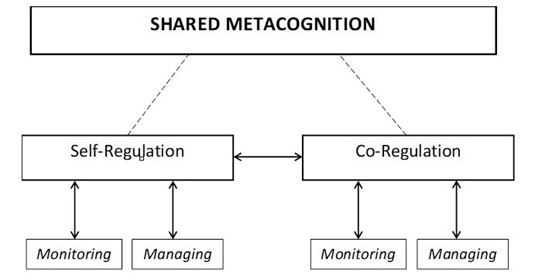
To explore the practical implications of shared MC, it is important to focus on the intersection of Cognitive Presence (CP) and Teaching Presence (TP). That begins with a consideration of TP categories (planning & organization; facilitation; and direction) as they overlap with CP operationalized through the phases of Practical Inquiry (triggering event, exploration, integration, and resolution). While there has been progress in defining and measuring the construct of shared MC, there has been an absence of research investigating the effective implementation and support for this process, which is the focus of this study (Garrison & Akyol, 2015a).
Mount Royal University in Calgary, Alberta offers a four-year Bachelor of Education program. In the fall of the third year, teacher candidates are engaged in a series of campus, place-based, and practicum experiences that focus on integrating Science, Technology, Engineering, Arts, Math, and Indigenous (STEAMI) education.
The semester begins with teacher candidates spending the first week in their practicum placements, helping their mentor teachers start the new school year with their K–12 students. The teacher candidates then spend one day a week in their mentor teacher’s classroom culminating in a five-week practicum experience.
On campus, the teacher candidates are engaged in a series of STEAMI education courses that are connected to weekly field trips. These trips include field work at the Ann and Sandy Cross Conservation Area (2020), Tim Hortons Children's Ranch (The Compass, 2020), and the Telus SPARK Science Centre (2020). The teacher candidates also spend a full day teaching STEAMI lessons to children at the Nakoda Elementary School (2020) on the Stoney Nakoda First Nations Reserve (Figure 4).
Figure 4
Nakoda Elementary School

Photo by Norman Vaughan, 2019.
This research study focuses on the educational technology course, which is included in the STEAMI semester. The purpose of this course is to provide an overview of technological influences in education. It is designed to assist prospective teachers in critically examining current and evolving applications of technology relevant to the teaching and learning process.
The primary objective of this research study was to investigate how an educational technology course for pre-service teachers can be designed, facilitated, and directed to help students develop their capacity for shared metacognition through the use of digital technologies.
An action research methodology was used for this study. This approach involved teacher candidates reflecting on how the shared metacognition construct could be developed in a higher education course. The intent of this research framework was to have some practical outcome related to the lives or work of the participants, which in this case was the growth and development of shared metacognition for teacher candidates (Stringer, 2014).
A mixed methods research approach guided the collection and analysis of the study data. Three sections of the educational technology course were offered in the Fall 2019 semester and the co-investigator invited the third-year teacher candidates to participate in this research study. There were eighty students enrolled in the course; seventy students were female (88%) and ten were male (12%). Ninety per cent of the students (n=72) agreed to participate in the study, which received approval from the Mount Royal University Human Research Ethics Board (HREB).
In terms of quantitative methods, the validated Shared MC (Appendix A) and CoI (Appendix B) surveys were both utilized in an online format using Google Forms. The Shared Metacognition survey (n=72) was deployed at the end of October, just before the teacher candidates began their five-week practicum placements in order to determine how they learned from each during the actual course component. The CoI survey was administered at the end of the Fall 2019 semester in order to observe how the teacher candidates had integrated their course experiences with their practicum placements (n=56). Descriptive statistics (frequencies, means, and standard deviations) were calculated for individual survey items using Google Spreadsheets.
With regards to qualitative methods, at the end of the Fall 2019 semester the teacher candidates created a final blog post where they reflected on how they contributed to the learning of others in the course as well as what they had learned from their peers. This data was copied and pasted into a Google Doc and the researchers used a constant comparative approach when reviewing the blog posts to identify patterns, themes, and categories of analysis that “emerged out of the data rather than being imposed on them prior to data collection and analysis" (Patton, 1990, p. 390).
The study findings about shared metacognition are reported using the three sub-elements or categories of the CoI’s sphere of teaching presence: design, facilitation, and direction.
Course design is a planning process that considers many content and process issues. The focus of the planning process for this research study was specifically on the monitoring and managing of shared metacognition.
At the beginning of the semester, the course instructor for the educational technology course had the students create an initial blog post where they described and shared their personal learning goals for the course as they related to the Mount Royal University (MRU) B.Ed. program’s five teaching competencies (planning, facilitation, assessment, classroom environment, professional roles, and responsibilities). At the end of the semester, the students were required to demonstrate and describe how they had achieved these learning goals by presenting the teaching competency pages of their professional learning plan or ePortfolio (Figure 5).
Figure 5
Planning for Learning Page: Professional Learning Plan
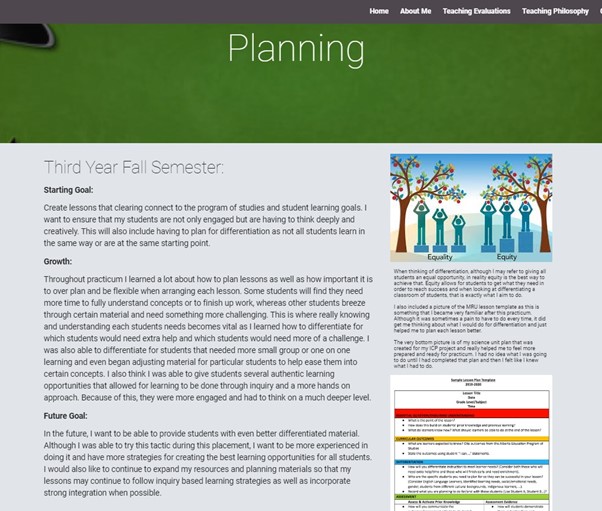
The study participants indicated these activities were useful on a personal level but several commented on the importance of the teacher “going over all assignments at the beginning of the semester to allow students to ask questions and also give us time to wrap our heads around the key concepts and goals of the course” (Shared MC survey participant 25). This comment was also reflected in the results from question two of the Community of Inquiry (CoI) survey, which asked students if their teacher clearly communicated important course goals (Figure 6).
Figure 6
The Instructor Clearly Communicated Important Course Goals. (CoI Survey, #2)
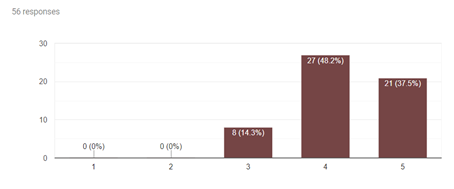
Note. A 5-point Likert-type scale, ranging from strongly disagree (1) to strongly agree (5), was used in the Community of Inquiry (CoI) survey.
Figure 6 indicates that the majority of students thought the teacher clearly communicated the course goals but fourteen per cent of the participants were ambivalent or “on the fence”. Interestingly, in the final blog post several students identified the benefit of group work in gaining a clearer understanding of the course and assignment expectations. “It made it easier to understand the course expectations and added more perspectives as to how to approach assignments when we worked in groups” (Student blog post 59). Another student commented that group work “ensures everyone is on the same page regarding assignment expectations” (Student blog 23).
Facilitation is the central activity in an educational community of inquiry for developing shared metacognition through the interactions among students and the teacher. Facilitative actions, “on the part of both the students and the teacher, create the climate, support discourse, and monitor learning. In the act of facilitation, learners connect with each other, engage with the content, are cognitively present as intellectual agents, and carry out all actions central to the development and maintenance of the learning community” (Vaughan et al, 2013, p. 46). In essence, the teacher is responsible for modelling the growth and development of shared metacognition in a course.
In the educational technology course, students selected critical friends at the beginning of the semester. The role of the critical friend was to provide constructive feedback and support for all of the course assignments. In addition, each of the course assignments had a group component where students were required to work together to solve problems and test solutions related to teaching with technologies (Figure 7).
Figure 7
Balance Board
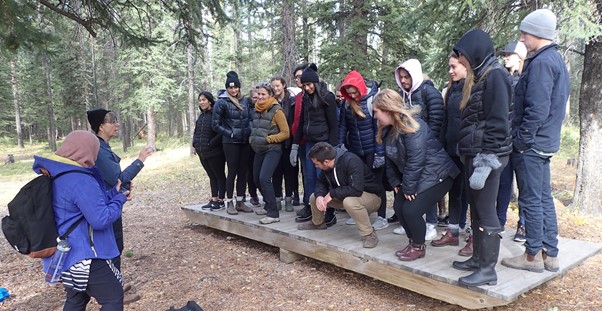
Photo by Norman Vaughan, 2019.
The purpose of this activity is to have students work collaboratively in order to balance a board so that it is not touching the ground.
The majority of research participants indicated that these collaborative activities helped them get to know the other students in the course, which gave them a sense of belonging (see Figure 8), and allowed them to feel comfortable interacting with their peers (Figure 9).
Figure 8
Getting to Know Other Course Participants Gave Me a Sense of Belonging (CoI Survey, #14)
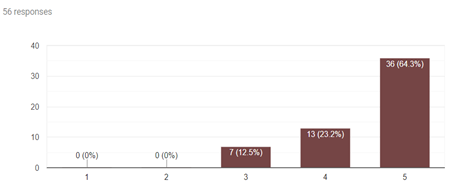
Highlighting the results of Figure 8, one student commented in their final blog post that through group work, “we were able to gain confidence about our individual ideas with support from our peers” (Student blog 71).
Figure 9
I Felt Comfortable Interacting With Other Course Participants (CoI Survey, #19)
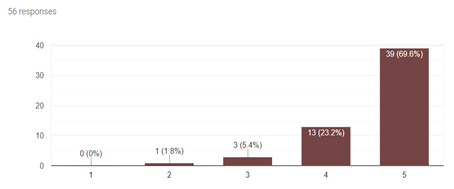
Another student indicated that their high-level comfort in group work contributed to “creating stronger working connections with peers, sharing ideas and resources, and receiving critical feedback, and strategies to improve teaching and planning” (Student blog 13).
In turn, this sense of a safe learning environment allowed students to be more willing to listen to the comments of others (Figure 10) as well as considering the feedback of their peers (Figure 11).
Figure 10
I Listen to the Comments of Other Students (Shared MC Survey, G2)
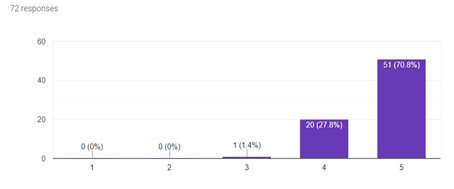
Note. A 5-point Likert-type scale, ranging from strongly disagree (1) to strongly agree (5), was used in the Shared Metacognition (MC) survey.
One participant emphasized that not only did she listen to others in the course, “I got to learn from others. I was also able to get new ideas and I was also able to share my ideas to others in my group” (Student blog 27).
Figure 11
I Consider the Feedback From My Peers (Shared MC Survey, G3)
![]()
Many participants in this study indicated that they had limited experience with peer feedback on assignments. For some, this requirement for all course assignments was revelational. “Working on an assignment and submitting it with zero feedback is a source of anxiety for me. However, having group members to give me constructive feedback on my assignments was the biggest advantage for me with group work” (Student blog 36).
Direct instruction is not about lecturing. Direct instruction is about ensuring students achieve the intended learning outcomes of a course or program. It is an essential ingredient in any formal educational experience in order to help students learn how to collaboratively manage and take responsibility for their learning (shared metacognition). It has been shown that students expect structure and leadership in higher education courses and the roles and responsibilities for direct instruction should be shared by all members of a Community of Inquiry (Garrison & Cleveland-Innes, 2005).
In terms of shared metacognition, some study participants indicated that they found it difficult to challenge their peers’ strategies and perspectives (Figures 12 and 13).
Figure 12
I Challenge the Strategies of Others (Shared MC Survey, G10)
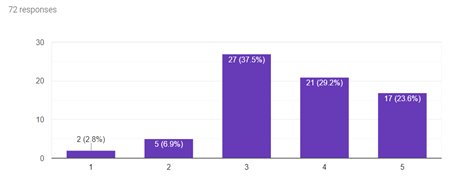
With regards to strategies, the participants commented specifically on work ethic and quality of work. Several of the students quoted the Pareto principle (Azad, 2013) where 20% of the group does 80% of the work: “usually one or two people ended up doing the work while other group members didn’t do anything” (Student blog 11). And, in terms of quality, one participant commented that “being able to trust others and their level of work is something I found difficult. I always want to try to strive for perfection (even when unattainable) so if I feel others are not as invested or do not put in as much work/effort it makes me upset” (Student blog 52).
Figure 13
I Challenge the Perspectives of Others (Shared MC survey, G11)
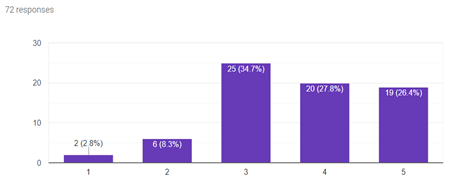
There were several comments about the challenge of negotiating different perspectives during group work. For example, one participant stated, “sometimes it can be difficult to cooperate with others that have different ideas and values. However, this is still a valuable experience” (Student blog 13). Another student explained how overcoming this type of challenge can be an important learning experience. “I had some group members that were quick to shut down others' ideas without backing up why. This was frustrating and at times hard to deal with, but it taught me to speak up and [develop] skills to positively work through an uncomfortable situation” (Student blog 33).
Finally, students are often unwilling to disagree or challenge each other in a higher education course, especially in online discussion forums as they do not want to offend or hurt anyone’s feelings, a sense of “pathological politeness” (Garrison, 2017. p.53). From the CoI survey results and the final blog posts, it was encouraging to see that by working in groups over the semester the study participants became more comfortable with providing direct instruction to each other (Figure 14).
Figure 14
I Felt Comfortable Disagreeing With Other Students in This Course While Still Maintaining a Sense of Trust (CoI Survey, #20)
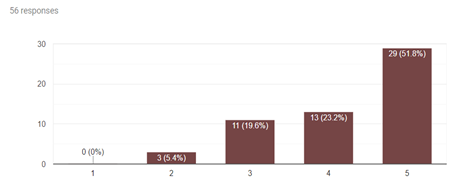
“I got to know more students in my program and made new friendships. These friendships helped me by providing me with people I trust to go to for information. They are people that I feel comfortable sharing my ideas with and taking risks within terms of disagreements” (Student blog 47). Another student commented, “this course helped me to formulate my teaching philosophy that knowledge is co-constructed through shared learning experiences. By working in groups, I didn't feel like I was working to build understanding alone” (Student blog 63).
Based on the findings from this study a series of recommendations are made below for using digital technology applications to design, facilitate, and direct a course in higher education. These recommendations are to help students develop their capacity for shared metacognition.
In terms of student engagement, Littky and Grabelle (2004) emphasize the importance of establishing relevance at the beginning of a course (the first R of engagement). They indicate that students should have a sense of curiosity and connectedness with the learning outcomes for the course. This can be achieved by having students complete an online needs assessment survey, share their relevant experiences in an online discussion forum, and create their own learning goals for the course in a blog.
Prior to the commencement of the course, the teacher can have students complete an anonymous needs assessment survey where they are asked about their expectations for the course. Questions could include the following:
1. What are your goals for this course? Bottom line, what do you want to ‘take away’ from your course experience?
2. What do you expect will happen during the class sessions? What will the professor do in class and what will you do?
3. What type of work do you expect to do outside of the classroom for this course, if any?
4. How do you think your learning in this course will be assessed?
5. What type(s) of assistance with your learning do you expect to receive in this course and from whom?
This online survey can be constructed using applications such as Google Forms and SurveyMonkey®. The key is to share and discuss the survey results with the students during the first class. The teacher can assign the students to small groups where they discuss the results and then share key findings with the entire class.
In addition, during the first week of the course, students can be engaged in an exercise where they each reflect back on an event that was a very powerful learning experience for them—it might or might not have been school related. The teacher can create a series of online discussion forums in the course learning management system (LMS) and then randomly assign five to six students to each forum. First, have the students share their learning experiences in their small groups and discuss why they were powerful. Second, debrief as a whole class about what makes learning experiences powerful. Then, using the CoI framework, co-create a set of engagement guidelines for the course.
Finally, students can use applications such as Google’s Blogger and WordPress to create reflective learning blogs for the course. In their first post, students can identify their personal learning goals for the course or program (Figure 15).
Figure 15
Personal Learning Goals for a Teaching Practicum
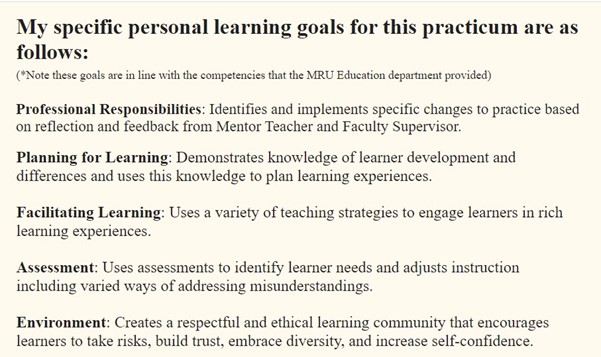
Norman Vaughan, 2019.
The students can then select critical friend(s) who are responsible for providing them with constructive feedback and support on the course assignments such as replying to blog posts (Figure 16).
Figure 16
Critical Friend Feedback on Blog Post

The second R of engagement that Littky and Grabelle (2004) advocate for is relationships. Creating a sense of community and collaboration are key for helping students develop their capacity for shared metacognition. Unfortunately, studies indicate that many students in higher education have little formal experience working collaboratively in groups (Chang & Brickman, 2018). Thus, the teacher must model the type of engagement behaviours they expect from the students and provide opportunities for students to learn how to work successfully in groups.
For example, collaborative activities can be designed that allow students to experience all five stages of Tuckman’s (1965) group development model (e.g., forming, storming, norming, performing, and adjourning). Ideally, this should be a low-stakes activity that takes place at the beginning of the semester so that students can obtain a first attempt in learning (FAIL) experience. In the case of an educational technology course, this could involve students collaboratively working together on a case study in order to come up with a solution to a school-related problem or issue (Rodgers,, 2017).
In addition, the participants of this study indicated that they had limited experience with the peer review process. The University of California in Los Angeles (2019) has developed a Calibrated Peer Review (CPR) tool (http://cpr.molsci.ucla.edu/Home)
This web-based application allows students to learn how to provide constructive feedback to their peers. There are three components to the CPR process: student writing, calibration training, and peer review. The first phase involves students creating a written piece of work based on a topic and in a format specified by the teacher. The second phase involves calibration training. Students assess three 'calibration' submissions against a detailed set of questions that address the criteria on which the assignment is based. Students individually assess each of these calibration submissions according to the questions specified by the rubric and then assign a holistic rating out of ten. Feedback at this stage is vital. If the assessments are poorly done and do not meet the teacher’s expectations, the students get a second try.
The quality of the assessments is considered in the third step, which involves the assessment of real submissions from other students. Once the deadline for calibration training has passed, each student is given anonymous submissions by three other students. They use the same rubric to assess their peers’ work, this time providing comments to justify their assessment and rating. Students assess their own submission after they have completed all three peer assessments (Likkel, 2012).
Littky and Grabelle’s (2004) third R of engagement is rigour. In a higher education course, this can involve students completing a challenging problem, task, or assignment that forces them to confront different perspectives and new ways of thinking. This process involves the teacher ‘nudging’ the students forward in their academic studies (Thaler & Sunstein, 2008). For example, students are often content to share and discuss ideas with each other but require a ‘gentle nudge’ to integrate and apply those ideas in course assignments and everyday life.
One recommendation for direct instruction is the explicit use of Garrison, Anderson, and Archer’s (2001) Practical Inquiry (PI) Model for course assignments. This model is based on the cognitive presence sphere of the Community of Inquiry framework and involves four phases of inquiry: triggering event, exploration, integration, and resolution (Figure 17).
Figure 17
Practical Inquiry Model (Garrison, Anderson, & Archer, 2001)
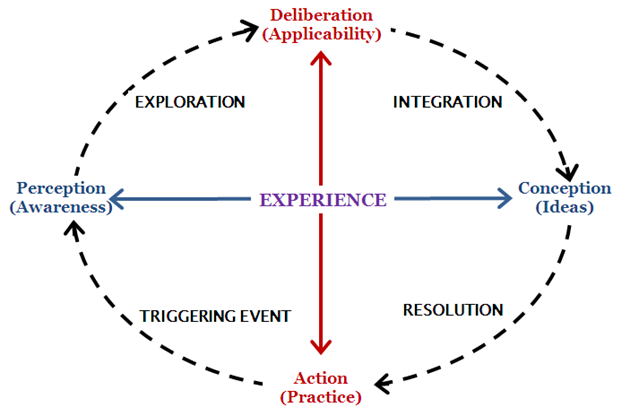
In online discussion assignments, students can use the PI model to self-code their forum posts in order to help them develop their metacognitive awareness and abilities. For example, they can label their posts as being either a triggering event, an exploration, integration, or resolution comment.
Another recommendation involves the use of learning contracts for group work. This can be a useful tool for helping students to plan and complete collaborative, inquiry-based project work. These contracts should be constructed by the students and reviewed by the teacher for constructive feedback and suggestions for modification. Both the students and the teacher should sign the final version of the learning contract. The contract then serves as an outline for the project and a tool to aid in the assessment process. Modification of the learning contract may become necessary as the learning experience progresses. Modified contracts should be approved and signed again by both the students and the teacher. Failure for a student to meet her or his contract obligations may result in expulsion from the team. Table 1 is an example of a sample learning contract, adapted from the work of Knowles (1986).
Table 1
Sample Learning Contract
| What are you going to learn? (Objectives) | How are you going to learn it? (Resources and Strategies) | Target date for completion | How are you going to know that you learned it? (Evidence) | How are you going to prove that you learned it? (Verification) | Instructor feedback (Assessment) |
| Itemize what you want to be able to DO or KNOW when tasks are completed. | What do you have to DO to meet each of the objectives defined? | When do you plan to complete each task? | What specific task will you complete to demonstrate learning? | Who will receive the product of your learning and how will they assess it? | How well was the task completed? Provide an assessment decision. |
| I have reviewed and find acceptable the above learning contract. | |||||
| Date: |
Students: |
Teacher: |
|||
The historical ideal of education has been to learn in collaborative communities of inquiry, which can foster the growth and development of shared metacognition (Lipman, 1991). The Maori of New Zealand refer to this as the concept of ako, which means to both teach and learn. (Alton-Lee, 2003). Ako recognizes the knowledge that both teachers and students bring to learning interactions, and it acknowledges the way that new knowledge and understanding can grow out of shared learning experiences. Hattie and Yates (2014) refer to this process as visible teaching and learning, “when teachers SEE learning through the eyes of their students and when students SEE themselves as their own teachers” (p. 14).
This research study has demonstrated the potential of using digital technologies and the Community of Inquiry framework (Garrison, 2017) to recapture a collaborative vision for higher education. The key is to use digital technology applications to redesign our courses for active and collaborative learning experiences that enable students to take responsibility for their learning and collaboratively validate their understanding through discourse and debate with their peers.
Alton-Lee, A. (2003, June). Quality teaching for diverse students in schooling: Best Evidence Synthesis Iteration (BES). New Zealand Ministry of Education.
Ann & Sandy Cross Conservation Area. (2020). Website. http://www.crossconservation.org/
Asad, K. (2013). Understanding the pareto principle (the 80/20 rule). Website. https://betterexplained.com/articles/understanding-the-pareto-principle-the-8020-rule/
Chang, Y., & Brickman, P. (2018). When group work doesn't work: Insights from students. CBE life sciences education, 17(3), ar42. https://doi.org/10.1187/cbe.17-09-0199
Chick, N. (2015). Metacognition: Thinking about one’s thinking. Vanderbilt University-The Centre for Teaching. https://cft.vanderbilt.edu/guides-sub-pages/metacognition/
Csíkszentmihályi, M. (1990). Flow: The psychology of optimal experience. Harper and Row.
Garrison, D. R. (2017). E-Learning in the 21st Century: A Community of Inquiry Framework for Research and Practice (3rd Edition). Routledge/Taylor and Francis.
Garrison, D. R., & Akyol, Z. (2015a). Toward the development of a metacognition construct for the community of inquiry framework. Internet and Higher Education, 24, 66–71. https://doi.org/10.1016/j.iheduc.2014.10.001
Garrison, D. R., & Akyol, Z. (2015b). Corrigendum to ‘Toward the development of a metacognition construct for communities of inquiry.’ Internet and Higher Education, 26, 56. https://doi.org/10.1016/j.iheduc.2014.10.001
Garrison, D. R., & Cleveland-Innes, M. (2005). Facilitating cognitive presence in online learning: Interaction is not enough. American Journal of Distance Education, 19, 133–148. http://dx.doi.org/10.1207/s15389286ajde1903_2
Garrison, D., Anderson, T., & Archer, W. (2001). Critical thinking, cognitive presence, and computer conferencing in distance education. American Journal of Distance Education, 15, 7–23. https://doi.org/10.1080/08923640109527071
Garrison, D. R., Anderson, T., & Archer, W. (2000). Critical inquiry in a text-based environment: Computer conferencing in higher education model. The Internet and Higher Education, 2(2-3), 87–105. http://cde.athabascau.ca/coi_site/documents/Garrison_Anderson_Archer_Critical_Inquiry_model.pdf
Hattie, J. & Yates, G.C.R. (2014). Visible learning and the science of how we learn. Routledge, Taylor & Francis Group.
Knowles, M. S. (1986). Using learning contracts. Jossey-Bass.
Kromydas, T. (2017). Rethinking higher education and its relationship with social inequalities: past knowledge, present state and future potential. Palgrave Communications 3(1). https://doi.org/10.1057/s41599-017-0001-8
Likkel, L. (2012). Calibrated peer review: Essays increase student confidence in assessing their own writing. Journal of College Science Teaching. 41(3), 42–47. https://www.learntechlib.org/p/88988/
Lipman, M. (1991). Thinking in education. Cambridge University Press.
Littky, D. & Grabelle, S. (2004). The big picture: Education is everyone's business. ASCD (Association for Supervision and Curriculum Development).
Nakoda Elementary School. (2020). Website. https://www.nakodaschool.ca
Patton, M.Q. (1990). Qualitative evaluation and research methods (2nd ed.). Sage Publications.
Regier, P. (2014, September 15). Using technology to engage the non-traditional student. EDUCAUSE Review, September/October, 2014, 70–88. https://er.educause.edu/articles/2014/9/using-technology-to-engage-the-nontraditional-student
Rodgers, D. (2017, August 2). Learning from failure: 6 Short edtech case studies you need to read [Blog post]. Schoology Exchange. https://www.schoology.com/blog/learning-failure-6-short-edtech-case-studies-you-need-read
Stringer, E.T. (2014). Action research (3rd ed.). Sage Publications.
Telus SPARK Science Centre. (2020). https://www.sparkscience.ca/
Thaler, R., & Sunstein, C. (2008). Nudge. Penguin Books.
The Compass. (2020). Tim Horton’s Children’s Ranch. Website. https://thethcompass.com/camps/tim-horton-childrens-ranch/
Tuckman, B. W. (1965). Developmental sequence in small groups. Psychological Bulletin, 63(6), 384–399. https://doi.org/10.1037/h0022100
University of California at Los Angeles. (2019). Calibrated Peer Review (CPR) tool. http://cpr.molsci.ucla.edu/Home
Vaughan, N.D., Cleveland-Innes, M. & Garrison, D.R. (2013). Teaching in blended learning environments: Creating and sustaining communities of inquiry. Athabasca University Press. http://www.aupress.ca/index.php/books/120229
Authors
Dr. Norman Vaughan, Ph.D. is a Professor in the Department of Education at Mount Royal University in Calgary, Alberta, Canada. He has co-authored the books Teaching in Blended Learning Environments: Creating and Sustaining Communities of Inquiry (2013) and Blended Learning in Higher Education (2008) and he has published a series of articles on blended learning and faculty development. Dr. Vaughan is the Co-founder of the Blended Online Design Network (BOLD), a member of the Community of Inquiry Research Group, the Associate Editor of the International Journal of Mobile and Blended Learning, and he is on the Editorial Boards of numerous national and international journals. Email: nvaughan@mtroyal.ca
Ms. Jessica Lee Wah, is the Administrative Assistant for the Department of Education at Mount Royal University. She is a graduate of Mount Royal’s Bachelor of English program with research interests in adult education.
5-point Likert-type scale
1 = strongly disagree, 2 = disagree, 3 = neutral, 4 = agree, 5 = strongly agree
SELF-REGULATION
When I am engaged in the learning process as an individual:
I1: I am aware of my effort.
I2: I am aware of my thinking.
I3: I know my level of motivation.
I4: I question my thoughts.
I5: I make judgments about the difficulty of a problem.
I6: I am aware of my existing knowledge.
I7: I assess my understanding.
I8: I change my strategy when I need to.
I9: I am aware of my level of learning.
I10: I search for new strategies when needed.
I11: I apply strategies.
I12: I assess how I approach the problem.
I13: I assess my strategies.
CO-REGULATION
When I am engaged in the learning process as a member of a group:
G1: I pay attention to the ideas of others.
G2: I listen to the comments of others.
G3: I consider the feedback of others.
G4: I reflect upon the comments of others.
G5: I observe the strategies of others.
G6: I observe how others are doing.
G7: I look for confirmation of my understanding from others.
G8: I request information from others.
G9: I respond to the contributions that others make.
G10: I challenge the strategies of others.
G11: I challenge the perspectives of others.
G12: I help the learning of others.
G13: I monitor the learning of others.
5-point Likert-type scale
1 = strongly disagree, 2 = disagree, 3 = neutral, 4 = agree, 5 = strongly agree
TEACHING PRESENCE
Design & Organization
1. The instructor clearly communicated important course topics.
2. The instructor clearly communicated important course goals.
3. The instructor provided clear instructions on how to participate in course learning activities.
4. The instructor clearly communicated important due dates/time frames for learning activities.
Facilitation
5. The instructor was helpful in identifying areas of agreement and disagreement on course topics that helped me to learn.
6. The instructor was helpful in guiding the class towards understanding course topics in a way that helped me clarify my thinking.
7. The instructor helped to keep course participants engaged and participating in productive dialogue.
8. The instructor helped keep the course participants on task in a way that helped me to learn.
9. The instructor encouraged course participants to explore new concepts in this course.
10. Instructor actions reinforced the development of a sense of community among course participants.
Direct Instruction
11. The instructor helped to focus discussion on relevant issues in a way that helped me to learn.
12. The instructor provided feedback that helped me understand my strengths and weaknesses relative to the course’s goals and objectives.
13. The instructor provided feedback in a timely fashion.
SOCIAL PRESENCE
Affective expression
14. Getting to know other course participants gave me a sense of belonging in the course.
15. I was able to form distinct impressions of some course participants.
16. Online or web-based communication is an excellent medium for social interaction.
Open communication
17. I felt comfortable conversing through the online medium.
18. I felt comfortable participating in the course discussions.
19. I felt comfortable interacting with other course participants.
Group cohesion
20. I felt comfortable disagreeing with other course participants while still maintaining a sense of trust.
21. I felt that my point of view was acknowledged by other course participants.
22. Online discussions help me to develop a sense of collaboration.
COGNITIVE PRESENCE
Triggering event
23. Problems posed increased my interest in course issues.
24. Course activities piqued my curiosity.
25. I felt motivated to explore content related questions.
Exploration
26. I utilized a variety of information sources to explore problems posed in this course.
27. Brainstorming and finding relevant information helped me resolve content related questions.
28. Online discussions were valuable in helping me appreciate different perspectives.
Integration
29. Combining new information helped me answer questions raised in course activities.
30. Learning activities helped me construct explanations/solutions.
31. Reflection on course content and discussions helped me understand fundamental concepts in this class.
Resolution
32. I can describe ways to test and apply the knowledge created in this course.
33. I have developed solutions to course problems that can be applied in practice.
34. I can apply the knowledge created in this course to my work or other non-class related activities.